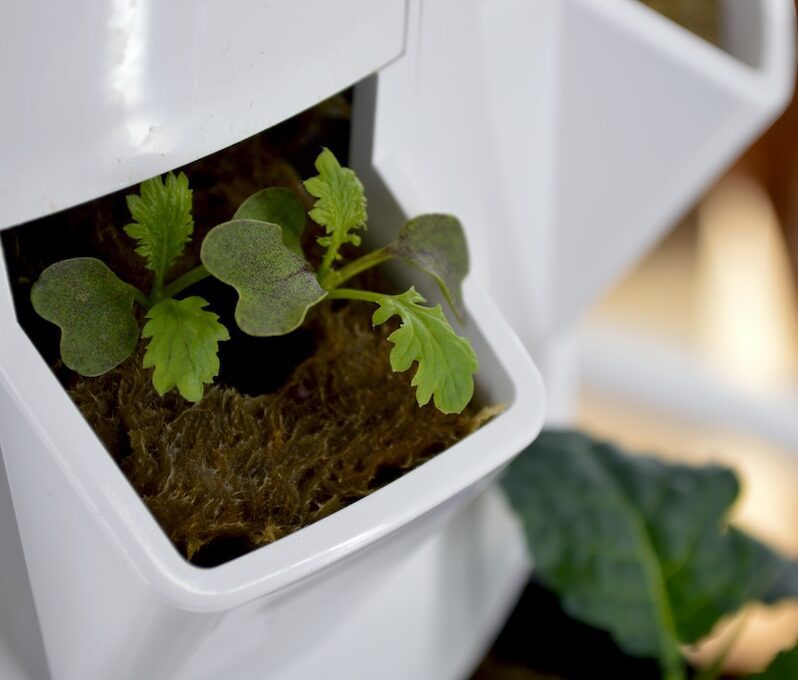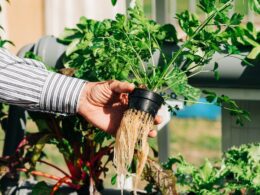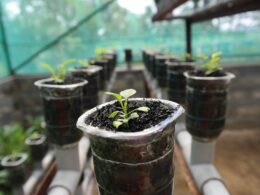Have you ever considered growing your own broccoli in a hydroponic system? Hydroponics is a method of growing plants without soil, using nutrient-rich water instead. It’s a popular option for those who want to grow vegetables indoors, in limited space, or in areas with poor soil quality.
But can broccoli, a cruciferous vegetable known for its health benefits, grow successfully in hydroponics? The answer is yes, but it comes with its own set of challenges.
To grow broccoli in hydroponics, you’ll need to understand the basics of this growing method and the specific needs of broccoli plants. In this article, we’ll explore the benefits and challenges of growing broccoli in hydroponics, provide tips for success, and guide you through the process of harvesting and enjoying your homegrown broccoli.
So, whether you’re a seasoned hydroponic gardener or just starting out, read on to learn how to grow your own delicious and nutritious broccoli.
Understanding Hydroponics
You’ll need to understand the basics of hydroponic systems if you want to successfully cultivate plants without soil. Hydroponics is a method of growing plants in water, without the use of soil. Instead, the plants receive all the necessary nutrients through a nutrient-rich solution.
Hydroponic gardening has become increasingly popular due to its numerous benefits. One of the benefits of hydroponic gardening is that it allows plants to grow faster and produce larger yields than traditional soil-based gardening. This is because the plants receive a constant supply of nutrients and water, which are essential for healthy growth. Additionally, hydroponic systems use less water than traditional gardening methods, making it a more sustainable option.
If you’re interested in hydroponic gardening, you can even create your own DIY hydroponic system. There are many different types of systems to choose from, such as deep water culture, drip irrigation, and nutrient film technique. With some basic tools and materials, you can set up your own system and start growing plants in no time. Just be sure to research the specific requirements for the plants you want to grow, as different plants have different nutrient needs.
Broccoli’s Growing Needs
To grow broccoli successfully, you need to ensure it gets enough light. It requires at least six hours of direct sunlight a day.
You also need to keep the temperature between 60 and 65°F for optimal growth.
Finally, you need to provide the plant with the right nutrients, including nitrogen, phosphorus, and potassium. This will ensure that it grows healthy and strong.
Light Requirements
Proper illumination is crucial for successful cultivation of broccoli in hydroponics. LED lighting is the most popular choice for indoor growers due to its energy efficiency and ability to produce specific wavelengths of light that plants need.
When it comes to broccoli, it requires at least 12 hours of light per day, with a light intensity of 300-500 µmol/m²/s. This level of light is necessary for the plant’s photosynthesis process, which is responsible for producing energy and growth.
While it’s important to provide enough light for your broccoli plants, it’s also crucial to avoid overexposure. Too much light can cause damage to the plant’s structure and reduce the quality of the crop. It’s recommended to monitor the intensity of the light and adjust accordingly.
Also, keep in mind that different stages of the plant’s growth require varying degrees of light intensity. For instance, during the seedling stage, the light intensity should be around 100-200 µmol/m²/s, while during the flowering stage, it should be higher, around 600-800 µmol/m²/s.
With proper attention to the light requirements, you can ensure a successful and bountiful harvest of broccoli in your hydroponic setup.
Temperature Needs
Maintaining the right temperature is crucial for ensuring that your hydroponic setup functions smoothly and your plants thrive. If you’re planning to grow broccoli in hydroponics, you need to be aware of the optimal conditions to meet its temperature needs. Here are a few things to keep in mind:
-
Broccoli seeds need a temperature of around 70°F to germinate properly.
-
Once the seedlings emerge, the ideal temperature range is between 60-65°F during the day and 50-55°F at night.
-
During the vegetative growth stage, the temperature range should be between 65-75°F during the day and 60-65°F at night.
-
As the plants move into the flowering stage, the temperature range should be kept between 60-65°F during the day and 50-55°F at night.
By keeping the temperature within this range, you can maximize the growth potential of your broccoli plants and ensure a bountiful harvest.
Remember to monitor the temperature regularly and make any necessary adjustments to maintain the optimal conditions for your plants.
As your broccoli plants move through the different growth stages, it’s important to provide them with the temperature and environmental conditions they need to thrive. By paying close attention to their temperature needs and providing them with a stable and comfortable environment, you can help your plants grow healthy and strong.
Keep in mind that temperature fluctuations can have a significant impact on your plants, so it’s essential to monitor and maintain the temperature within the optimal range. With the right conditions, your hydroponic broccoli can grow into a healthy and delicious addition to your table.
Nutrient Requirements
Now let’s talk about what your plants need to thrive – specifically, the nutrients they require for optimal growth. Broccoli, like any other plant, needs a balanced diet of macronutrients and micronutrients to grow healthy and strong. The good news is that hydroponic systems allow for precise control over the nutrients delivered to the plants, ensuring that they receive exactly what they need.
To achieve the best results, it’s essential to understand the broccoli nutrient ratios required for hydroponic nutrient delivery. In general, broccoli plants require higher levels of potassium and calcium compared to other nutrients like nitrogen and phosphorus. This can be achieved by using a nutrient solution with a balanced NPK ratio of 1:2:2 and supplementing it with calcium and magnesium. Here’s a table that summarizes the recommended nutrient ratios for growing broccoli in hydroponics:
| Nutrient | Ratio |
|---|---|
| Nitrogen (N) | 100 ppm |
| Phosphorus (P) | 200 ppm |
| Potassium (K) | 400 ppm |
| Calcium (Ca) | 200 ppm |
| Magnesium (Mg) | 100 ppm |
By providing the right nutrient mix, you can ensure that your broccoli plants grow to their full potential and produce a bountiful harvest. Remember to monitor your nutrient levels regularly and adjust as necessary to maintain the optimal balance of nutrients for your plants.
Challenges of Growing Broccoli in Hydroponics
When growing broccoli in hydroponics, you’ll face several challenges. One of the most important is maintaining optimal pH levels to ensure the plants get the nutrients they need.
You’ll also need to focus on preventing disease and pest management, which can be more difficult in a hydroponic system.
Finally, providing sufficient support for plant growth is crucial to ensure that your broccoli plants thrive.
Maintaining Optimal pH Levels
Achieving the perfect pH balance is key to ensuring your plants thrive in a hydroponic system.
Optimal pH testing is the first step in maintaining the right balance. You can use pH monitoring equipment to test the pH level of your hydroponic solution.
Once you have determined the pH level, you can use pH balancing solutions to adjust the pH level to the optimal range for your plants. It’s important to note that adjusting techniques should be used with caution, as over-adjusting the pH level can harm your plants and reduce nutrient uptake efficiency.
To avoid this, make small adjustments and monitor the pH level regularly. By maintaining the optimal pH levels, you can ensure that your broccoli plants grow healthy and strong in your hydroponic system.
Preventing Disease and Pest Management
To keep your plants healthy and thriving, it’s important to prevent disease and manage pests in your hydroponic system.
One way to prevent diseases is to ensure that your hydroponic system is clean and free from any debris or dead plant material. You can also use a sanitizing solution to clean your equipment and growing medium before and after planting.
Pest control is another important aspect of maintaining a healthy hydroponic system. One way to control pests is to use natural predators such as ladybugs or lacewings. You can also use sticky traps or insecticidal soap to control pests.
It’s important to monitor your plants regularly and take action as soon as you notice any signs of pest infestation. By taking these preventive measures, you can ensure that your hydroponic system remains disease-free and pest-free, allowing your broccoli plants to grow and thrive.
Providing Sufficient Support for Plant Growth
You’ll need to make sure your plants are getting the support they need to reach their full potential when cultivating broccoli in a hydroponic system. Vertical gardening can be a great way to provide this support, as it maximizes space while allowing plants to grow upward. By using trellises or other structures, you can encourage your broccoli plants to grow tall and strong, ensuring they receive adequate light and nutrients.
In addition to vertical gardening, alternative substrates can also help support your broccoli plants. Rather than using traditional soil, consider using materials like coconut coir, perlite, or vermiculite. These substrates are lightweight, porous, and provide excellent drainage, which can help prevent overwatering and root rot.
By choosing the right support system for your plants, you can ensure they thrive and produce a bountiful harvest.
Is Hydroponics a Suitable Method for Growing Lettuce?
Hydroponics has emerged as a suitable method for growing lettuce. By eliminating soil and using nutrient-rich water solutions, lettuce in hydroponics systems exhibits accelerated growth and higher yields. This method allows for precise control of environmental factors like temperature, pH, and nutrient levels, ensuring optimal conditions for lettuce cultivation.
Tips for Growing Broccoli in Hydroponics
If you’re looking to add some greenery to your indoor garden, these tips will help you cultivate a bountiful harvest using just water and nutrient-rich solutions. Growing broccoli in hydroponics is a great way to get fresh veggies without soil.
The first step is to choose the right broccoli varieties for hydroponics. Some of the best ones include Calabrese, Romanesco, and Purple Sprouting. Once you have your broccoli seeds, it’s time to choose the right nutrient solutions for your hydroponic system. You can either purchase pre-made nutrient solutions or make your own using a mix of macronutrients and micronutrients.
Make sure to test the pH levels regularly and adjust the nutrient solution accordingly. Broccoli plants need plenty of nitrogen, calcium, and magnesium to thrive, so make sure your solution has enough of these elements. In addition to providing the right nutrients, it’s important to give your broccoli plants plenty of light and support.
Make sure they get at least 12 hours of light per day, either from natural sunlight or grow lights. As the plants grow, use trellises or stakes to support the stems and prevent them from bending or breaking. With these tips in mind, you can grow healthy and delicious broccoli in your hydroponic system.
Harvesting and Enjoying Your Broccoli
Now it’s time to reap the rewards of your hard work and savor the delicious taste of your homegrown broccoli bounty. Harvesting your broccoli is easy – simply cut the central head when it reaches a size of about 4-7 inches in diameter. This will encourage the plant to produce more side shoots, so you can continue to harvest for weeks to come.
Don’t forget to also harvest the leaves, which are just as nutritious and delicious as the florets. Once you’ve harvested your broccoli, it’s time to enjoy it! There are many cooking techniques that work well with broccoli, including steaming, roasting, stir-frying, and even grilling.
No matter how you choose to cook it, make sure not to overcook your broccoli, as this can destroy some of its nutrients. Broccoli is not only tasty, but also packed with health benefits, including vitamins C, K, and A, as well as fiber and antioxidants.
So go ahead and experiment with different recipes, and enjoy the many health benefits of this delicious vegetable. Whether you enjoy it as a side dish, in a stir-fry, or as a topping for your pizza, your homegrown broccoli is sure to be a hit. And who knows, maybe you’ll even inspire your friends and family to start their own hydroponic gardens!
Frequently Asked Questions
What are the advantages of growing broccoli in hydroponics compared to traditional soil-based methods?
Growing broccoli in a hydroponic system has many advantages over traditional soil-based methods. Hydroponic broccoli is known to have higher nutritional benefits than soil-grown broccoli because the plants can absorb nutrients more efficiently in a controlled environment.
There are also no pests or weeds to contend with, which eliminates the need for harmful pesticides. Hydroponic systems use less water and space than traditional methods, which makes them ideal for urban farming.
Overall, growing broccoli in a hydroponic system allows for a safer and more sustainable way to produce nutrient-rich vegetables.
Can hydroponic broccoli be grown without the use of pesticides or other chemicals?
If you’re looking for a healthier and safer way to grow broccoli, then organic hydroponic broccoli is the way to go. Unlike traditional soil-based methods that rely on pesticides and other chemicals, hydroponic broccoli can be grown without the use of harmful substances.
This means that you can enjoy the nutritional benefits of broccoli without worrying about the potential dangers of chemical residues. In fact, hydroponic broccoli nutrition is often superior to that of conventionally grown broccoli.
By using a controlled environment and nutrient-rich water solutions, hydroponic broccoli is able to grow faster and contain more vitamins and minerals. So if you’re concerned about the safety of your food, try growing your own organic hydroponic broccoli and enjoy the taste and health benefits of this amazing vegetable.
How long does it take for broccoli to mature when grown in hydroponics?
Broccoli growth rates can vary depending on the optimal hydroponic conditions. Under ideal conditions, broccoli can mature in as little as 60 days, while in less optimal conditions, it can take up to 100 days.
To ensure the best growth rates, it’s important to maintain the correct water pH, nutrient levels, and temperature. With proper care and attention, hydroponic broccoli can be grown to maturity free from the use of pesticides or other harmful chemicals.
By providing a safe and controlled environment for your plants, you can ensure that you’re providing healthy and nutritious produce for yourself and your loved ones.
Is it possible to grow other vegetables alongside broccoli in a hydroponic setup?
Looking to maximize your hydroponic garden space? Companion planting is a great way to grow multiple vegetables together in a single hydroponic setup.
When choosing which vegetables to plant alongside broccoli, it’s important to consider their nutrient requirements. Broccoli requires high levels of calcium and nitrogen, so it’s best to choose vegetables that have similar nutritional needs.
Some great options for companion planting with broccoli include lettuce, spinach, and kale. These leafy greens have similar nutrient requirements and can thrive alongside broccoli in a hydroponic setup.
So, go ahead and experiment with companion planting to create a thriving hydroponic garden that provides all the nutrients you need in one space.
Can hydroponic broccoli be grown in a small space, such as an apartment balcony or rooftop garden?
Looking for small space solutions to grow your own food?
Broccoli can be grown in hydroponics, which is a great alternative method for those with limited outdoor space. With the right equipment and setup, you can easily grow hydroponic broccoli on your apartment balcony or rooftop garden.
Hydroponics allows for precise control over the growing environment, ensuring optimal growth and yield. Plus, it’s a great way to avoid pesticides and harmful chemicals commonly found in store-bought produce.
So why not give hydroponic broccoli a try and enjoy the benefits of growing your own food in a small space?
Conclusion
So, you’re thinking about growing broccoli in hydroponics. While it can be a challenge, it’s definitely possible. Hydroponics allows for precise control over the growing environment, which can be especially helpful for meeting broccoli’s specific needs.
However, it’s important to remember that broccoli does have some unique challenges when grown in hydroponics, such as the need for ample light and nutrients.
If you’re up for the challenge, there are some tips that can help you successfully grow broccoli in hydroponics. These include choosing the right variety, providing plenty of light, maintaining proper nutrient levels, and monitoring the pH of your water.
With a little bit of patience and dedication, you can enjoy a bountiful harvest of fresh, delicious broccoli right from your hydroponic garden. So why not give it a try and see what you can grow?









